1981 ->: Early
History of US National Sevens Rugby Teams
1. 1981-1985: US
International Sevens Begins
The Hong Kong Only
Years
Emil
Signes
JANUARY 9, 2016
(rev. 2/6/2016- 18:48)
tc
Background and
Summary
It was brought to my attention that,
as our beloved sevens game has become an Olympic sport after many
years of the World Series of Sevens, the early pioneers of sevens
in the US could well fade into the background. The difficulties we
faced, even the occasional ridicule of sevens as a worthy game,
will be forgotten. It is my hope to shed some light on those early
years, as they deserve to be celebrated. It is my intention in
this article to present, for posterity, the early history of the
US's participation in international sevens rugby beginning with
our first-ever national sevens team, the 1981 Eagles.
The approach will be chronological, with a brief introduction
incorporating the history of sevens prior to 1981. The World
Series of Sevens began in 1998 and the first few years - including
the US's loss of core status to regaining it 2008-09. From
the time we were resettled into core status the history has been
covered by others.
International sevens was men-only through 1996. I was
named coach to the Women's National Sevens Team in 1996.
We held a large camp in Philadelphia in August with just Hong
Kong's word that there would be a tournament the next
year. In 1997, international women's sevens was officially
inaugurated at the Hong Kong Invitation Women's Rugby Sevens
(HKIWRS). The women's game continued to expand, first
beyond Hong Kong, then as participants in the 2009 Rugby World
Cup Sevens in Dubai, then as part of its own World Series of
Sevens, and finally as equal participants in the upcoming (as I
write) first-ever rugby sevens at the 2016 Olympic games.
Both US men and US women have qualified and will be among the
small group of 12 teams of each sex at the Olympic event.
As I was the founder of the US women's sevens program - which
ushered in international sevens* - I take great personal pride
in the story I tell in the following link.
* see Boys
and Girls Together: Olympics and Me
Sevens Rugby
1883-1976
The first seven-a-side rugby
tournament was held in Melrose, Scotland on April 28, 1883. Ned
Haig, a playing member of the Melrose, Scotland rugby club,
devised the concept sevens tournament to make money for his club.
That part sounds familiar. A history of the Melrose Sevens may be
found at Wikipedia: Melrose_Sevens
History
Sevens remained local to Scotland and northernmost England until
well after World War I. Finally, sevens made it to London:
on April 24, 1926, the first Middlesex Sevens was played. Whereas
the aim of the Melrose club in 1883 had been to raise money for
their club, the Middlesex committee's aim was to make their
tournament a fun event, in order to end the rugby season in a
cheerful social atmosphere. Middlesex would soon be able to boast of being the largest
7s' tournament in the world, selling out the 60,000 seat
Twickenham stadium annually. Wikipedia's
history of the Middlesex Sevens may be found here: Middlesex_Sevens
History
First-Ever
International Sevens Rugby, Scotland 1973
The first sevens' tournament to
feature national teams was held in Scotland in 1973. Once again,
as in 1883, the Scots were to lead a trend, although it was viewed
as a curiosity at the time: the inside front cover of the program
was an advertisement for Peter Scott Knitwear, featuring a man and
woman in sweaters, looking amazed and accompanied by the caption:
"International Seven-a-Sides. What next?" See First
International Sevens Tournament: Scotland 1973
The Start of
Continuous Sevens: Hong Kong, 1976
But though Scotland, again, led the
way in sevens, it took the Hong Kong Sevens to actually move
sevens to become a world-wide popular sport. In Hong Kong in 1976,
as at Melrose 93 years earlier, 7s were chosen for logistical
reasons: it was a lot easier to bring in twelve 7s' teams than
twelve 15s' teams. The scope was originally narrowed to Asian and
Pacific nations, but it grew rapidly; the US first participated in
1981.
It is interesting to note that while most nations, including
Australia and New Zealand, entered full national teams into the
Hong Kong Sevens as early as the 1970s, it wasn't until 1993 that
England, faced with the loss of an invitation to Hong Kong, became
the last country to enter a full national side.
The history of the Hong Kong Sevens is summarized here: Hong_Kong_Sevens
History
The program below lists 12 teams: Australia, Fiji, Hong Kong,
Indoneisa, Japan, Korea, Malaysia, New Zealand, Singapore, Sri
Lanka, Thailand, Tonga. Only Australia and New Zealand did
not have national teams, being represented by invitation sides
Wallaroos and Cantabrians.
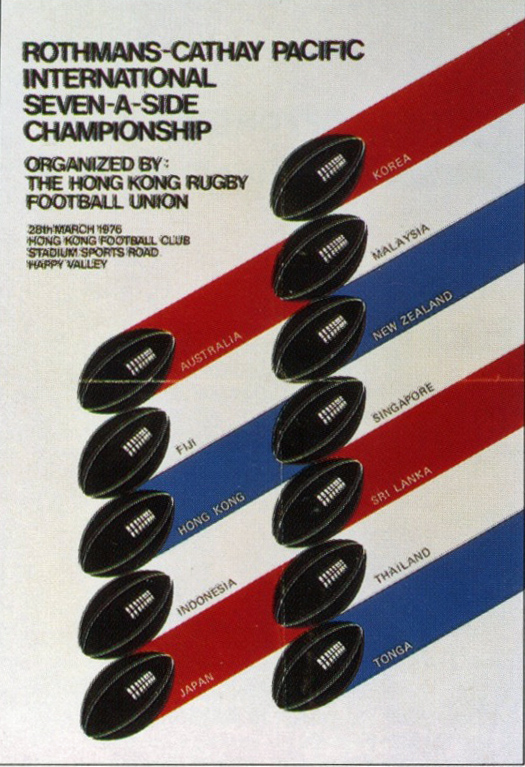
1976 Hong Kong Program.jpg
Program for the first-ever Hong Kong Sevens (1976)
The US at Hong Kong 1981-85
With the invitation of the USA for
the first time in 1981, US sevens was - with some exceptions -
limited to Southern California and to a stretch of the East Coast,
which made the process of selection nontrivial; a lot of the
selection was necessarily based on determining how current 15s
Eagles projected to sevens. As the 80s progressed, an official All Star event - the ITT
(Interterritorial Tournament) 7s began in 1985. Players that
stood out at this event began to be integrated into the team and a
more formal selection process was instituted.
1981. Hong Kong Sevens (March
28-29, 1981)
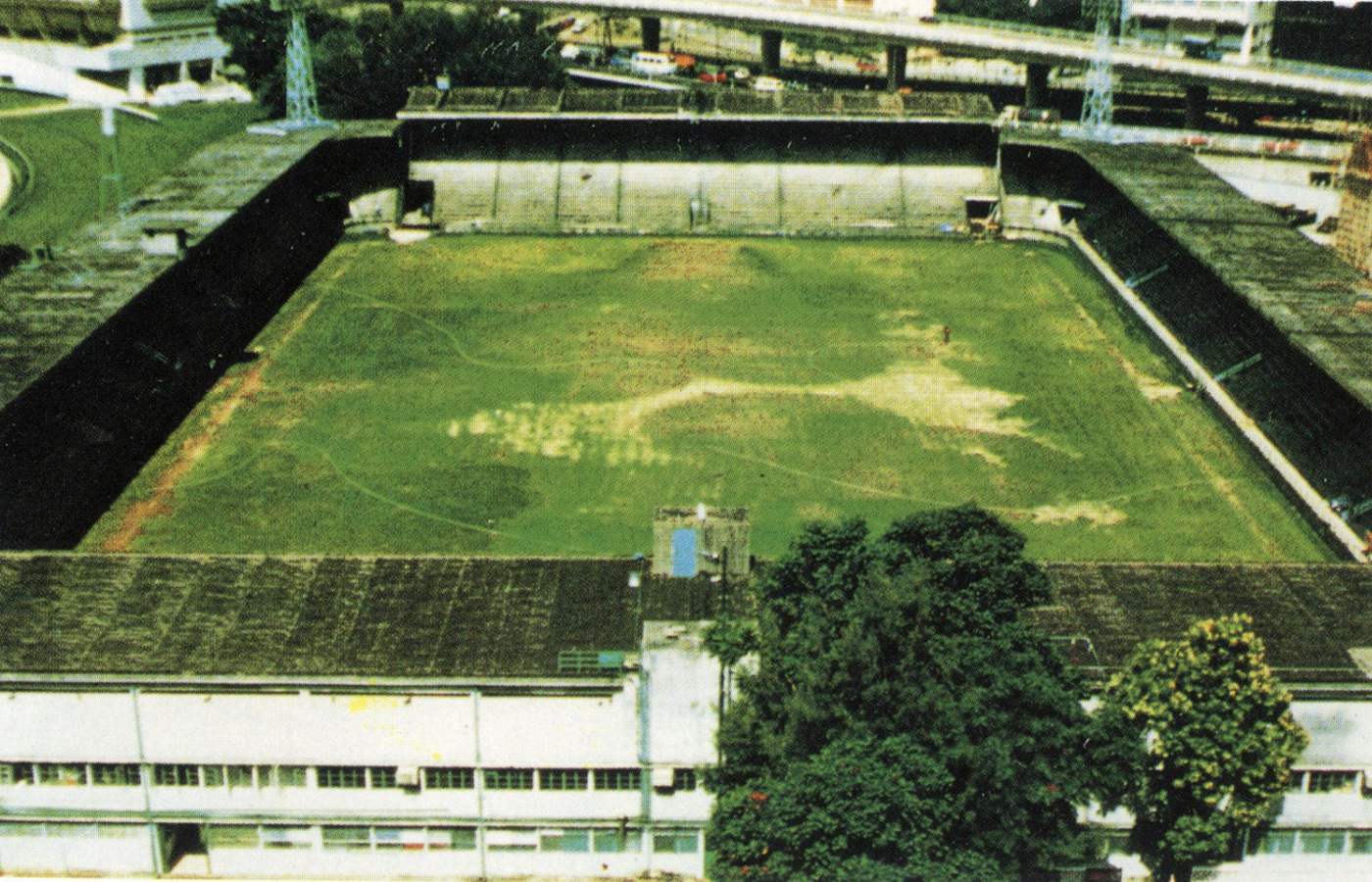
1981-1985 HK Government Stadium-1000w.jpg
Hong Kong Football Club: Home of the Hong Kong Sevens 1976
through 1981
Photo from The Hong Kong The Sevens:
Celebrating Twenty Years by John Blondin
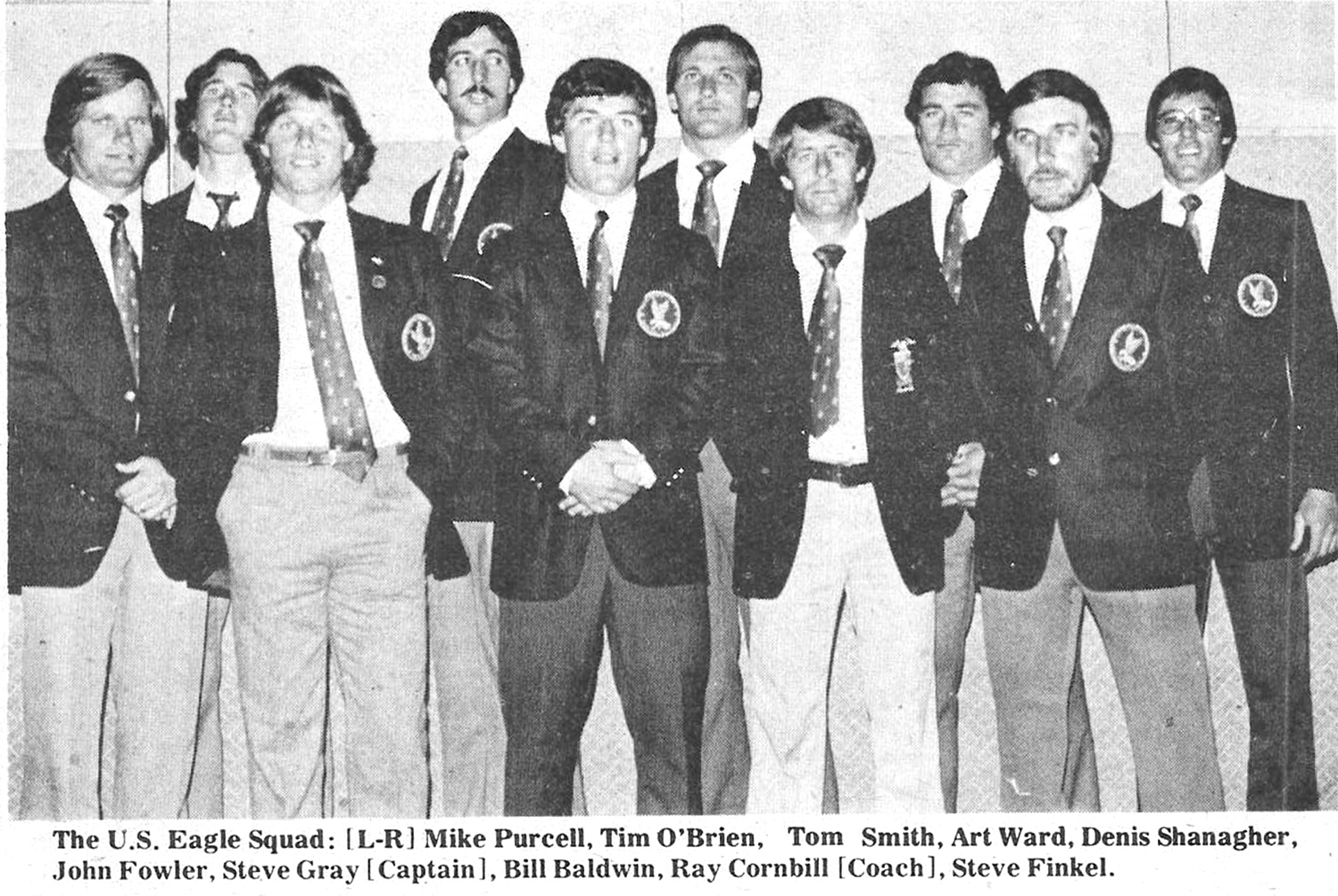 1981-03 Eagles at HK
7s-1200w.jpg
The First-Ever USA Eagles Sevens
Squad: March 28-29, 1981
1981-03 Eagles at HK
7s-1200w.jpg
The First-Ever USA Eagles Sevens
Squad: March 28-29, 1981
The US was first invited to the Hong
Kong Sevens for 1981 and eagerly accepted. This first-ever
USA Sevens team was coached and managed by Eagle 15s coach Ray
Cornbill and selected by the National Selection Committee, chaired
by Keith Seaber. The team trained in CA following the
Monterey Tournament and also in Hong Kong, where the preparation
included a joint session with Korea.
Bill Baldwin, Denver Highlanders
Steve Finkel, Scioto Valley
John Fowler, UCLA
Steve Gray (captain), OMBAC (Old Mission Beach Athletic Club)
Tim O'Brien, Old Blues (CA)
Mike Purcell, BATS (Bay Area Touring Side)
Denis Shanagher, BATS (Bay Area Touring Side)
Tommy Smith, UCLA
Art Ward, Old Blues
Here is a picture from the first 10 years of Hong Kong 7s book,
referenced above.
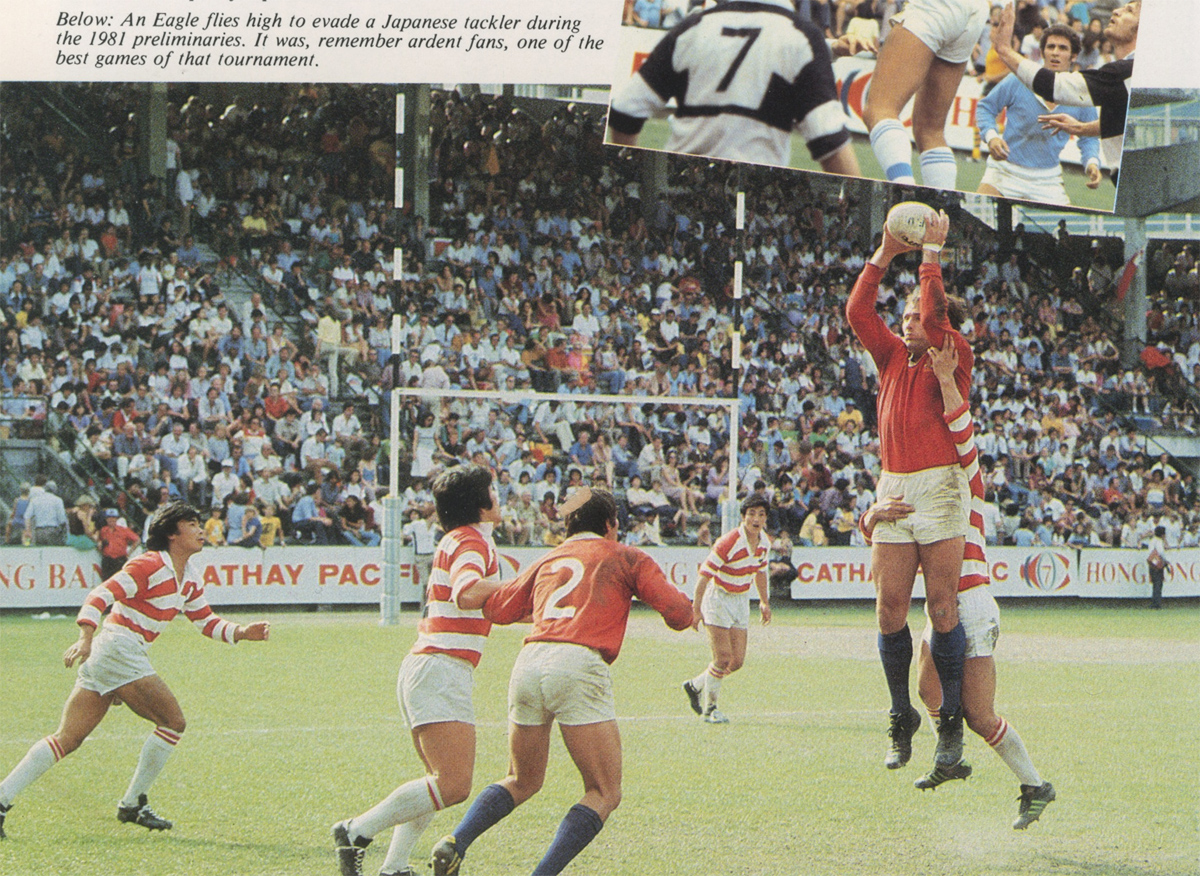 1981-03 Eagle LO at HK7s-1200w.jpg
John Fowler goes up for lineout
vs. Japan
1981-03 Eagle LO at HK7s-1200w.jpg
John Fowler goes up for lineout
vs. Japan
Steve Finkel is #2
US Results at Hong
Kong 1981 (W3 L3)
The write-up is excerpted from the
April 20, 1981 Rugby Magazine. Click
here for the article.
US 10 Barbarians 20. The Barbarians comprised
English and Welsh internationals experienced in sevens play, and
were the tournament favorites. The Eagles started with good
ball movement, including an American football pass, to take a 4-0
lead on a Mike Purcell try. Following that the Barbarians scored 4
unanswered tries until John Fowler closed out the scoring with a
40-y interception and try that Tommy Smith converted.
US 18 Sri Lanka 0. Denis Shanagher scored the first
try on a 60-y run. Bill Baldwin and Steve Gray scored the other 2
tries, and all 3 were converted.
US 0 Western Samoa 24. The nation currently known as Samoa
is identical to the nation formerly known as Western Samoa.
The name was changed in July 1997. The Samoans had continual
possession in this game and scored up the middle due to defensive
lapses.
US 24 [South] Korea 10. (North Korea doesn't play rugby so
whenever Korea is mentioned in this history it is South
Korea.) Steve Finkel opened the scoring with a 75-y run in
which he ran over 2 would-be tacklers. Mike Purcell was set up by
teammates for 3 tries. All 4 tries were converted by Smith.
US 12 Papua New Guinea 10 (Plate Quarterfinal).
John Fowler grabbed a lineout and scored a 50-y try. Mike Purcell
stiff-armed a defender, ran down the sideline and scored in the
center for a converted try. Papua New Guinea had a nice
oomeback, but both conversions failed and the US got the win.
US 14 Japan 18 (Plate Semifinal). Per
the press, one of the best games of the tournament. Japan
stormed out to an 18-0 half-time lead. The US came storming back,
though. Tim O'Brien scored the first try on a pass from
Tommy Smith. Finkel made a long break and made a beautiful
behind-the-back pass to Smith who scored in the corner. Steve Gray
ran off a penalty play and scored under the posts. There was time
left and the article tells us that the fans were going crazy about
the Eagle comeback. The Eagles had what appeared to be two
legitimate tries called back and the score remained 14-18.
Our reporter finished his article with "So it goes."
Not much was expected from the Eagles in their first appearance,
but they exceeded expectations. Ray Cornbill notes that "in
the press, we were the surprise of the tournament for sure."
The Barbarians squeaked by Australia to win the tournament
championship 12-10, and Tonga defeated Japan 22-18 for the Plate.
1981 was the last year the tournament took place in Hong Kong
Football Stadium, capacity 2,750. Bigger things were in store.
1982. Hong Kong Sevens
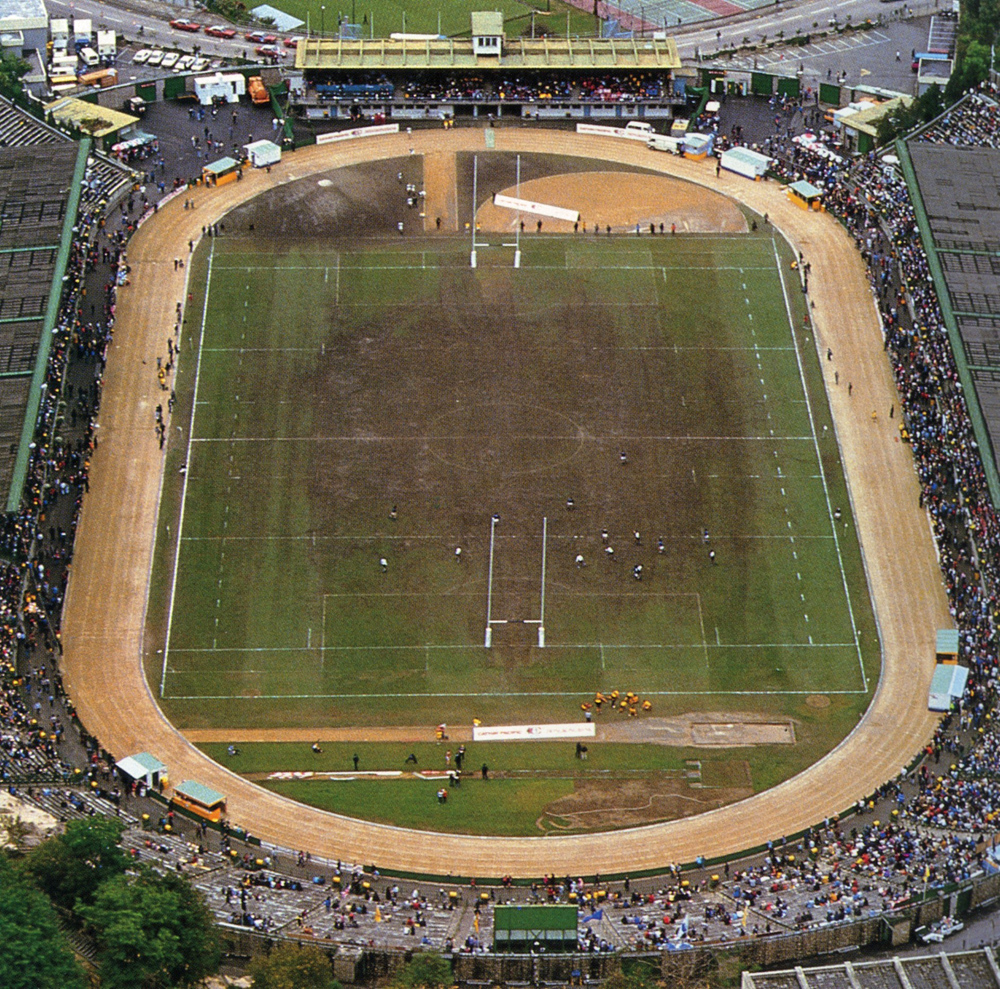 Hong
Kong Government Stadium: "the" Sevens were here from 1982 to
1992
Photo from The Hong Kong Sevens (first 10
years) by Kevin Sinclair
The current Hong Kong Stadium was built directly on this
spot starting just after the 1992 Sevens
Hong
Kong Government Stadium: "the" Sevens were here from 1982 to
1992
Photo from The Hong Kong Sevens (first 10
years) by Kevin Sinclair
The current Hong Kong Stadium was built directly on this
spot starting just after the 1992 Sevens
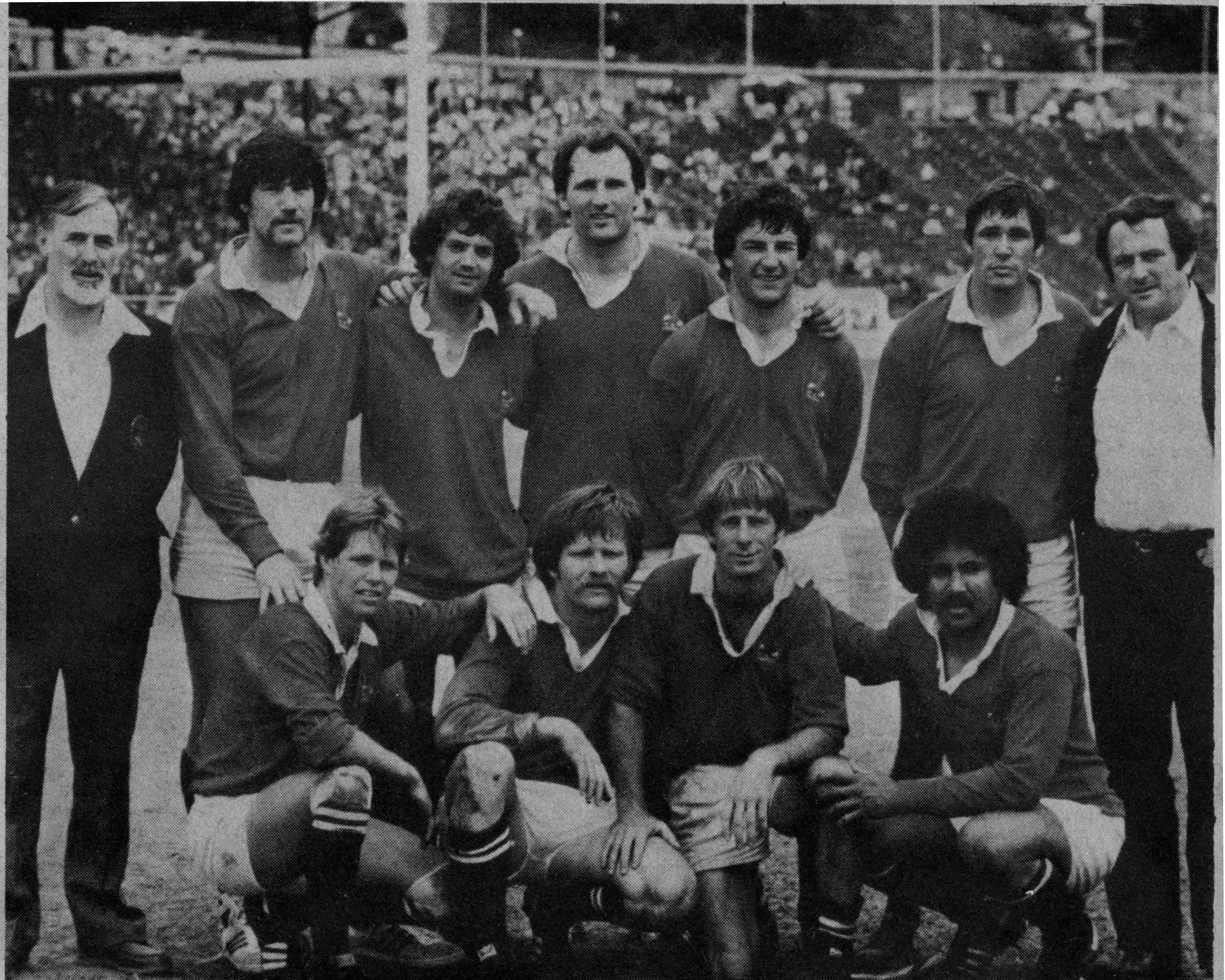 1982-03 USA Eagles at
HK.jpg
Eagles in Hong Kong March 27-28,
1982
1982-03 USA Eagles at
HK.jpg
Eagles in Hong Kong March 27-28,
1982
Standing, L to R: Keith Seaber (manager), Gary Lambert, Dave
Bateman, John Fowler, Denis Shanagher, Steve Finkel, Dennis
Storer (coach)
Below: Tommy Smith, Mike Purcell, Steve Gray, Roy Helu
Management was represented by coach Dennis Storer and manager
Keith Seaber and Dennis Storer. The players were
Dave Bateman the Elder*, Old Blues (CA)
Steve Finkel, Scioto Valley
John Fowler, Santa Monica
Steve Gray (captain), OMBAC (Old Mission Beach Athletic Club)
Roy Helu, Old Blues (CA)
Gary Lambert, White Plains
Mike Purcell, BATS (Bay Area Touring Side)
Denis Shanagher, BATS (Bay Area Touring Side)
Tommy Smith, UCLA
* Two Dave Batemans have represented the US sevens team.
This Dave Bateman, from San Francisco, represented the US from
1982 through 1985.
US Results at Hong
Kong 1982 (W3 L2)
The tournament moved this year
from the Hong Kong Football Club (capacity 2,750) to Hong Kong
Stadium (capacity 28,000). The results are excerpted
from the April 19, 1982 Rugby Magazine; whose article
is shown here: the
article may be found by clicking here.
US 40 Singapore 0. The US opened the scoring in the
2nd minute when Denis Shanagher drew a defender and sprung Roy
Helu for the try. Shanagher scored the second try and Mike
Purcell made a 60-m run to score a third, and a 50-m run for a
fourth. and Roy Helu converted the first 3. In the second
half, Shanagher, Gary Lambert, and John Fowler scored tries and
Helu converted all 3.
US 4 Fiji 30. The
Eagles had all the play in the first couple of minutes but
couldn't put it across the line; following a turnover Fiji
scored; 0-6. Fiji scored a second try in the half, but the US
got on the board with a nice set up Tommy Smith to Gary Lambert
who scored With the score 4-10 at halftime, Fiji took over
and scored 4 tries in the second half.
US 30 Japan 6. Japan
had knocked the US out of the Cup competition in 1981 but the US
dominated this game. Fowler tapped down the opening kickoff to
Finkel, to Gray, to Lambert who took it all the way for the try.
The US missed several opportunitie in the next few minutes, but
in the last couple of minutes of the half, Purcell and Fowler
scored. Smith converted all 3 first-half tries.
US 28 Malaysia 10.
This final pool match was played on Sunday morning and the US
needed a win to get to the Cup. Rugby Magazine called it
a "real US show." John Fowler made a nice fingertip catch of a
Roy Helu pass for a nice score and the crowd exploded. Tommy
Smith converted. Dave Bateman and Steve Finkel scored two
more unconverted tries in the first half. Mike Purcell, Helu and
Finkel scored in the second half. Smith converted one try this
half. After Malaysia scored to start the 2nd half, the US won a
LO at their own 5-meter line. Fowler won the ball and got it to
Purcell who scored a length of the field try. The final try was
on a counter-attack of a Malaysia kick; Fowler scored the long
try.
US 4 Scottish Borders 14 (Cup Quarterfinal).
Rugby reports that this was a very good match, with the crowd very
much behind the Eagles. There were a lot of good passing
movements by both team, with the half time score 0-4 to the
Borders. The Scots then scored an early 2nd half try but the US
came back with an unconverted Steve Finkel try, but the Borders
team scored the last try and the US lost 4-14. It was a tough way
to go out, but the Eagles were deservedly appreciated and loudly
applauded by the crowd.
Australia defeated the Scottish Borders in the Cup championship
game, 18-14.
1983. Hong Kong Sevens
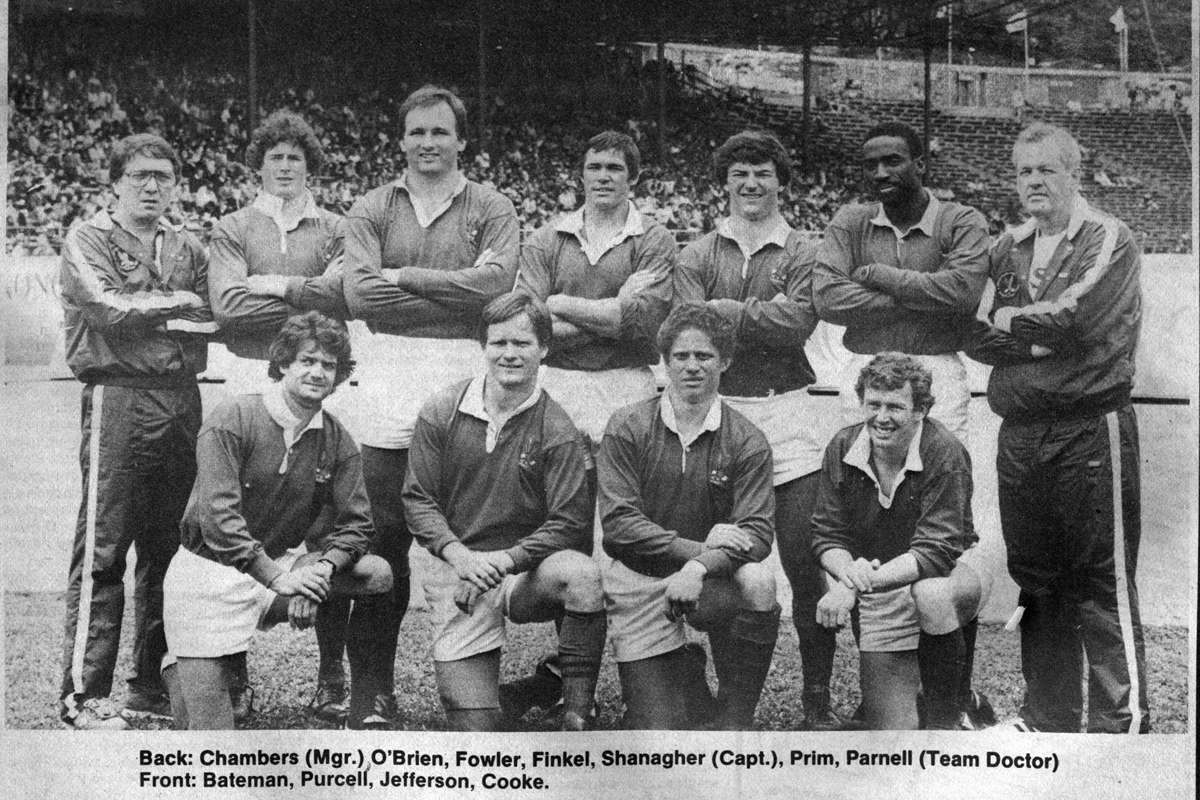
1983-03 Eagles at HK.jpg
Eagles in Hong Kong March 26-27,
1983
Back: David Chambers (manager), Tim
O'Brien, John Fowler, Steve Finkel, Denis Shanagher, Richard
Prim,
Peter Parnell, team physician
Front: Dave Bateman, Mike Purcell,
Willie Jefferson, Dick Cooke
Keith Seaber, not pictured, was the coach of this team.
Keith Seaber was the coach, David Chambers the manager, Dr. Peter
Parnell the team physician, and the players were
Dave Bateman the Elder, Old Blues (CA)
Dick Cooke, Memphis Olde #7
Steve Finkel, Scioto Valley
John Fowler, Santa Monica
Willie Jefferson, Santa Monica
Tim O'Brien, Old Blues (CA)
Richard Prim, San Antonio STARS (South Texas Area Side)
Mike Purcell, BATS (Bay Area Touring Side)
Denis Shanagher, BATS
(Bay Area Touring Side)
US Results (W2 L3)
The
results are excerpted from the April 18, 1983 Rugby
Magazine; click
here for the article.
US 12 Bahrain 10. The US
would have lost to Bahrain, a team composed mostly of British and
New Zealand expats, had it not been for a penalty try. Willie
Jefferson scored the other try, and Dick Cooke converted both; the
second conversion, of the penalty try, won the game.
US 6 [South] Korea 16. This game took place
during the torrential rain that started during day 1. Based on the
writeup, Korea, playing the rain, continually kicked through the
US line, whereas the US attempted unsuccessfully to play wide open
attacking rugby without success. Mike Purcell scored the US try
converted by Steve Finkel.
US 42 Singapore 0. This was a track meet, as the US scored
7 tries in 14 minutes. John Fowler led with 3, Willie Jefferson
had 2 and Denis Shanagher and Tim O'Brien and Dick Cooke one each.
Cooke had 5 conversions.
US 0 New Zealand 26. By this game, the write-up tells us,
the pitch was covered in ankle-deep mud and the Eagles injury
situation caused them to have to play with center Denis Shanagher
at prop. This was the first year that New Zealand would field a
full national team in Hong Kong, and one of its players was future
and current legendary coach Gordon Tietjens.
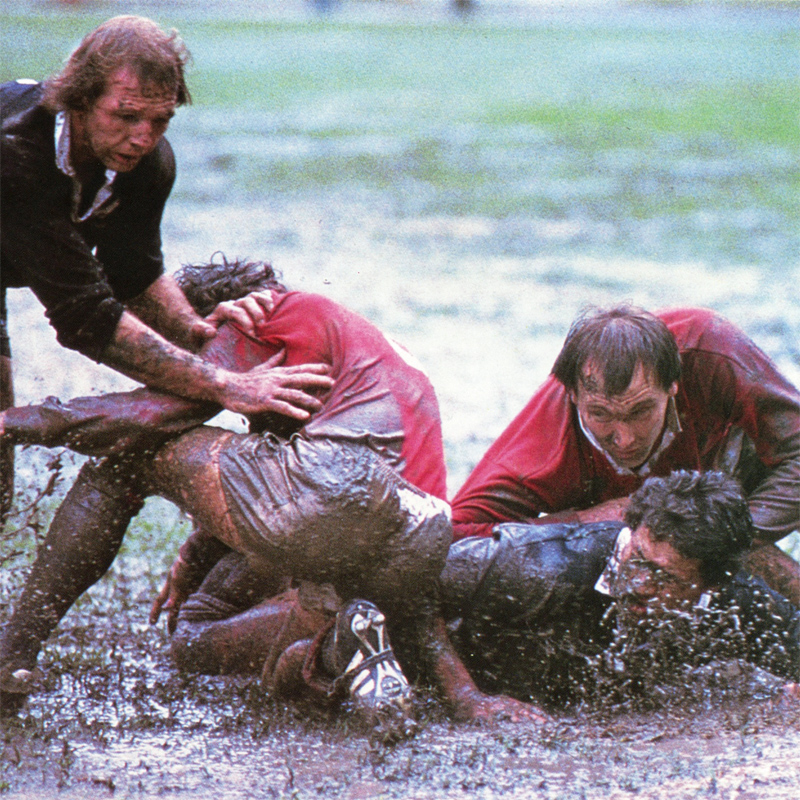 1983-03 US NZ in mud at
HKG.jpeg
US vs NZ in the mud
John Fowler looking up
1983-03 US NZ in mud at
HKG.jpeg
US vs NZ in the mud
John Fowler looking up
On the left is current (2016) New Zealand Sevens Coach Gordon
Tietjens
US 0 Scottish Borders 12 (Cup
Quarterfinal). Despite being 2-2 in pool play, the US
made the Cup quarterfinal based on points. Injuries
continued to plague them (squad size was 9 at the time), and Steve
Finkel summed up the game, "We just didn't have the horses. And
those we had were out of position." And, in general, Scots are
more used to playing in the rain/mud than Americans.
1984. Hong Kong Sevens
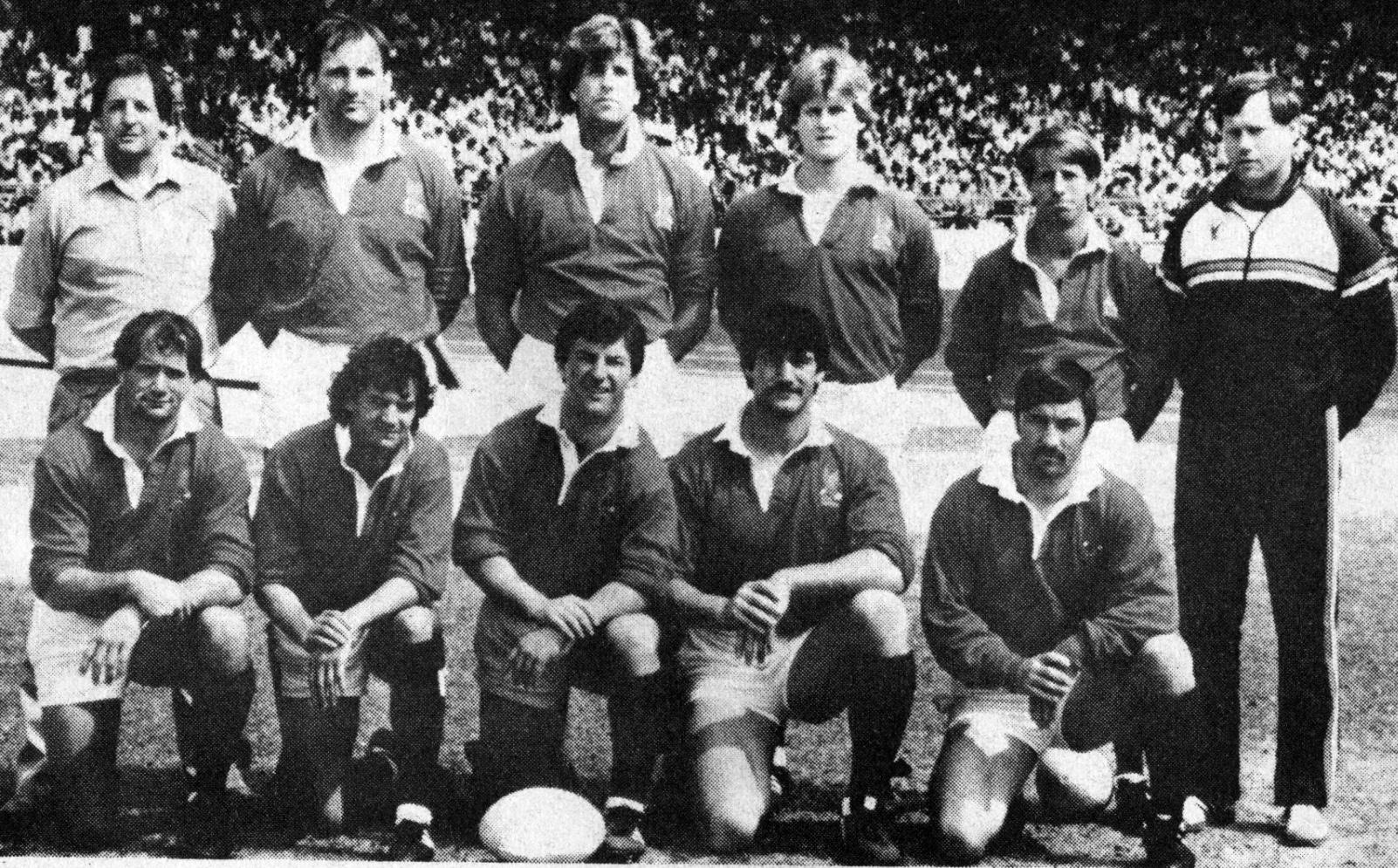 1984-0331 Eagle 7s in
HK.jpg
Eagles in Hong Kong March
31-April 1, 1984
Standing, L to R: George Betzler
(coach), John Fowler, Mark Deaton, Dave Priestas, Steve Gray,
Bob Watkins
Kneeling, L to R: Dave Jenkinson,
Dave Bateman, Denis Shanaghan, Gary Lambert, Blane Warhurst
1984-0331 Eagle 7s in
HK.jpg
Eagles in Hong Kong March
31-April 1, 1984
Standing, L to R: George Betzler
(coach), John Fowler, Mark Deaton, Dave Priestas, Steve Gray,
Bob Watkins
Kneeling, L to R: Dave Jenkinson,
Dave Bateman, Denis Shanaghan, Gary Lambert, Blane Warhurst
George Betzler was the coach and Bob Watkins the manager. The
players were
Dave Bateman the Elder, Old Blues (CA)
Mark Deaton, Old Blues (CA)
John Fowler, Cincinnati Wolfhounds
Steve Gray, U. of Miami
Dave Jenkinson, Oklahoma University
Gary Lambert, Life Chiropractic
Dave Priestas, Bethlehem Hooligans (PA)
Denis Shanagher (captain), BATS (Bay Area Touring Side)
Blane Warhurst, Old Blues (CA)
US Results (2-2)
The results are excerpted from the
April 16, 1984 Rugby Magazine. Click
here for the article.
US 18 Papua New Guinea 4. This
was a tightly contested first half, ending at 4-4, the Eagles' try
by Blane Warhurst. The second half was all US. Dave Priestas - my
homie - scored the first try in his first Eagle match ever. John
Fowler and Denis Shanagher also scored two tries, and Shanagher
added a conversion.
US 10 Crawshay's Welsh 14 US. This was in the days when the
UK nations couldn't bear to send sevens teams bearing the nation's
name, so Wales was represented by the invitational team
Crawshay's. Dave Jenkinson, like Priestas playing in his
first-ever Eagles' match scored the first try, converted by Steve
Gray and the US led 6-4 at halftime. In the second half the Welsh
scored twice to take a 14-6 lead, and though the Eagles attacked
fiercely in the 2nd half, they only produced a last second Gary
Lambert try.
US 18 Tonga 0 (Plate Quarterfinal). A win over Tonga
is always a good result. Playing classic keep-away sevens, the US
backed up to near its goal line before Gary Lambert broke the line
for a 90-m try. Jenkinson scored the second try on another long
run to make the half-time score 8-0. Dave Jenkinson followed with
another long run, converted by Shanagher, and the final try was
scored by Dave Bateman who kicked over the Tonga sweeper. He
gathered it himself and scored.
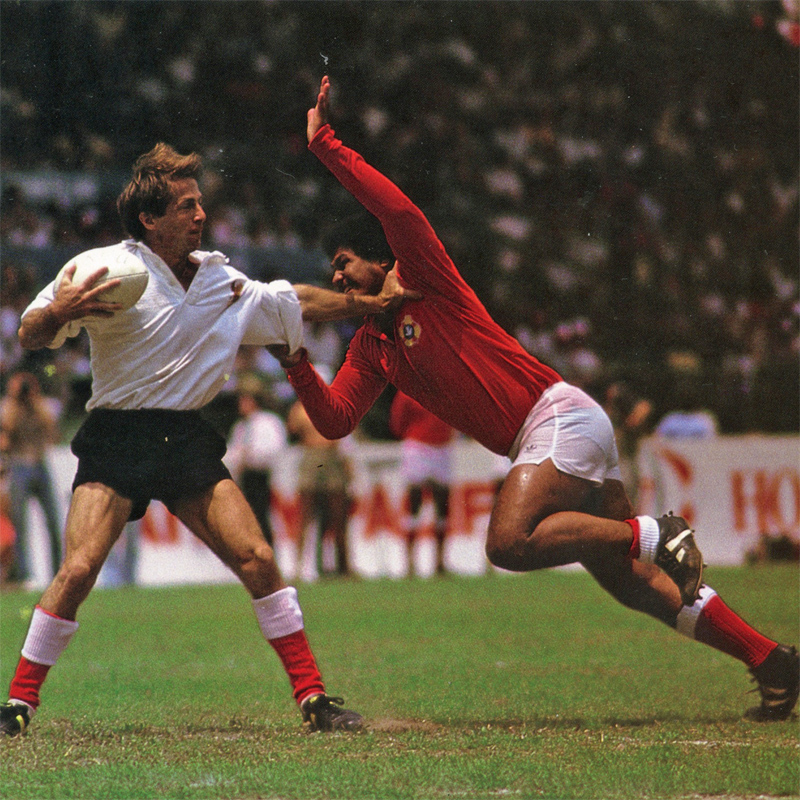 1984 US Steve Gray
vs Tonga.jpeg
Steve Gray holds off a Tongan
defender
1984 US Steve Gray
vs Tonga.jpeg
Steve Gray holds off a Tongan
defender
US 8 Japan 10 (Plate Semifinal). The write-up makes it
clear that this was a game the Eagles should have won. They got an
8-0 lead, including a try described in detail in which all 7
players handled the ball. In the second half, however, Japan kept
the ball away from the US and put kicks behind the US line, twice
to score and later to put the ball deep into US territory, where
they defended well.
Fiji overwhelmed New Zealand 26-0 in the tournament final.
1985. Hong Kong Sevens
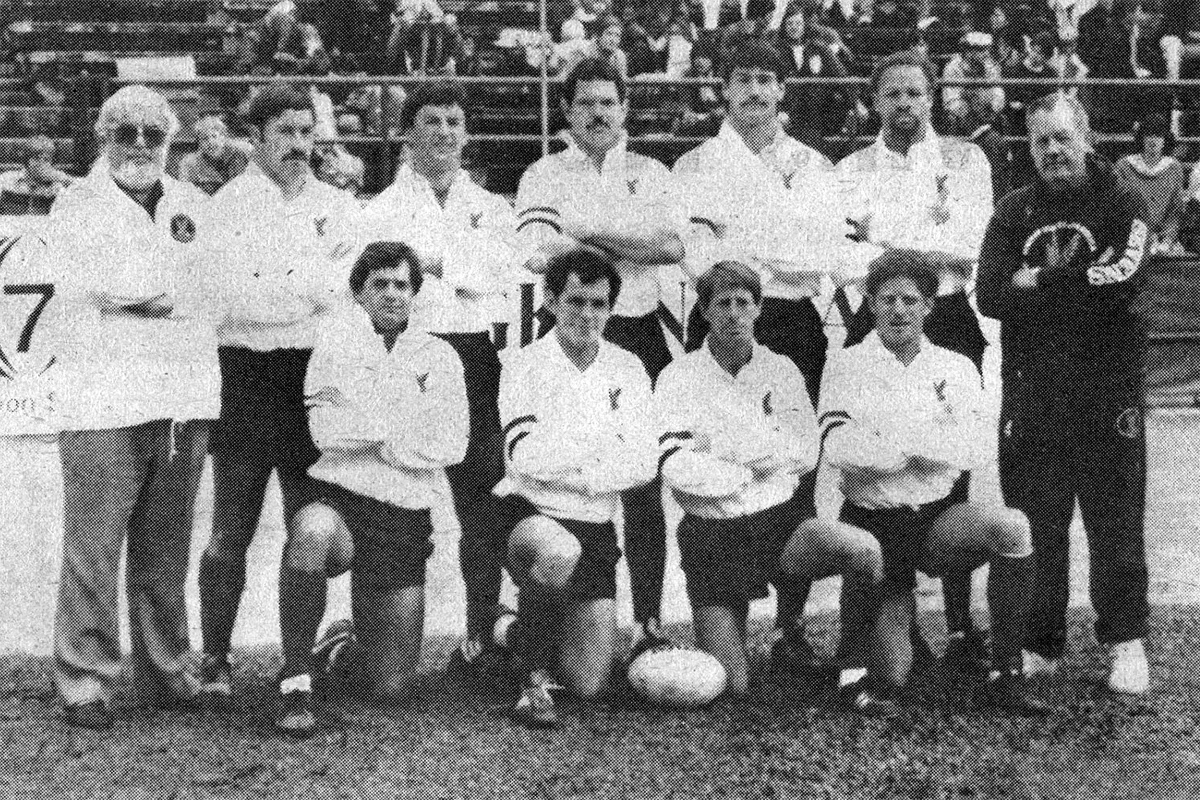 1985-0330 Eagles in
HK-1200w.jpg
Eagles in Hong Kong March 30-31,
1985
Standing, L to R: Bob Jones
(manager), Blane Warhurst, Denis Shanagher, Jake Burkhardt, Gary
Lambert, Terrence Titus, Peter Parnell (team physician)
Kneeling, L to R: Dave Bateman,
Charlie Wilkinson, Steve Gray, Willie Jefferson
1985-0330 Eagles in
HK-1200w.jpg
Eagles in Hong Kong March 30-31,
1985
Standing, L to R: Bob Jones
(manager), Blane Warhurst, Denis Shanagher, Jake Burkhardt, Gary
Lambert, Terrence Titus, Peter Parnell (team physician)
Kneeling, L to R: Dave Bateman,
Charlie Wilkinson, Steve Gray, Willie Jefferson
Bob Jones was the manager. I'm told Captain Steve Gray also
served as team coach. The players were
Dave Bateman the Elder, Old Blues
Jake Burkhardt, Cincinnati Wolfhounds
Steve Gray, OMBAC
(Old Mission Beach Athletic Club)
Willie Jefferson, Harlequins (London, England)
Gary Lambert, Life College
Terrence Titus, Life College
Denis Shanagher, BATS (Bay Area Touring Side)
Blane Warhurst, Old Blues (CA)
Charlie Wilkinson, Duck Brothers (NOVA 15s)
Selection for this team was partly based on the two events that
took place in San Diego February 15-18 1985. Those events
were a 4-day national selection camp for the US 15s team, and
squashed in the middle, the first-ever ITT (AKA All-Star) Sevens
held in San Diego on Sunday the 17th. Some of the players in
the sevens had also been invited to the 15s camp, and it was a
very difficult weekend for them. It wasn't a great solution
for the sevens players who wanted to focus on the sevens, and as
one of the coaches of the camp said, "although the sevens was
inspirational, it used up valuable camp time and effort."
The weekend got national selectors and players to watch the sevens
candidates, but it was not - fortunately - a template for future
events, as it was difficult for those involved in both - players
and selectors - to focus on one event.
US Results (2-2)
The
results are excerpted from the April 15, 1985 Rugby
Magazine. Click
here to see the article.
The Eagles were crippled by injury
before and during the tournament. From Rugby Magazine,
April 15, 1985, the US "was forced to play much of the tournament
without its fastest players. David Jenkinson and Mike
Purcell, two of the fastest players in the Eagle Camp, withdrew
from the team prior to the tournament because of injuries.
Also, wing Willie Jefferson was limited to two games after
aggravating a leg injury sustained in the Eagle Trials. In
addition player-coach Steve Gray suffered broken hand in the
match against Canada, ending his tournament availability."
This was in the days of 9-player squads, and the US had to borrow
two players, one from Canada and one from Korea, as reserves in
its final match.
US 28 Brunei 3. The US actually fell behind in this game as
Brunei slotted a penalty to go ahead 3-0. Willie Jefferson
scored two first half tries to put the Eagles ahead 8-3, and the
US took control in the second half with tries by Charlie
Wilkinson, Denis Shanagher, Terrence Titus and Steve Gray plus two
Gray conversions.
US 4 New Zealand 20. The US's only score in this game
was by Dave Bateman.
US 14 Canada 4 (Plate Quarterfinal). This was the US's best
result of the tournament. Denis Shanagher and Dave Bateman scored
in the first half, and Shanagher converted one for a 10-0 lead.
Canada scored in the second half, but a limping Jefferson scored
the 3rd try to seal the game midway through the second half and
the US won won 14-4.
US 8 Bahrain 10 (Plate Semifinal). As satisfying as the
Canada win was, so disappointing was the Plate SF loss to
Bahrain. Playing keep away, the US was backed up to its goal
line leading to a Bahrain score. Lambert scored between the posts,
but we missed a conversion leaving the score at 4-4. Terrence
Titus scored in the second half but Bahrain tied the score with a
try in the corner with no time left. They made the very
difficult conversion and a golden opportunity slipped away.
Australia were the 1985 Cup champions.
Only a Festival
Game?
Sometimes I can be prescient. At this
time, sevens was still regarded as an oddity, something to be
played in warm weather, a day out with your friends. But
horrors! People (like me) that took it seriously were laughed at.
I had coached sevens for nearly 10 years and had long ago fallen
in love with the game, and I was offended every time I heard
disparaging comments about its validity as a real sport.
The ITT 7s (Inter-territorial 7s) had begun in January 1985, and I
was the coach of the old Eastern Rugby Union that had just won the
2nd ITTs in December 1985. The four territorial coaches
joined the national selection panel to discuss 1986 selections. To
calm down the very enthusiastic, the Chairman of Selectors warned
that sevens was after all merely a festival game. That
discussion prompted the following article, one in a series I wrote
about Sevens (Ed Hagerty, editor of Rugby Magazine, chose
me to write this series because I was one of the
"enthusiastic sevens guys" - and maybe because I was happy to
write for free:)).
Time proved that I was in the right place at the right time.
International sevens was about to expand.
And a few months later - following the 1986 international sevens
events - I was named National Sevens Coach. - Emil

1986-02 Only a Festival Game.jpg
Continued:












